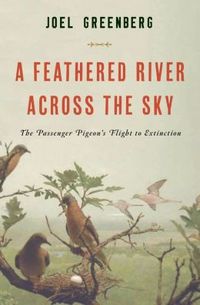

Purchase
A Feathered River Across The Sky
Joel Greenberg
The Passenger Pigeon's Flight to Extinction
Bloomsbury
January 2014
On Sale: January 14, 2014
304 pages
ISBN: 1620405342
EAN: 9781620405345
Kindle: B00GC53ACM
Hardcover / e-Book
Add to Wish List
Non-Fiction History
In the early nineteenth century 25 to 40 percent of North
America’s birds were passenger pigeons, traveling in flocks
so massive as to block out the sun for hours or even days.
The down beats of their wings would chill the air beneath
and create a thundering roar that would drown out all other
sound. Feeding flocks would appear as “a blue wave four or
five feet high rolling toward you.”
John James
Audubon, impressed by their speed and agility, said a lone
passenger pigeon streaking through the forest “passes like a
thought.” How prophetic—for although a billion pigeons
streamed over Toronto in May of 1860, little more than fifty
years later passenger pigeons were extinct. The last of the
species, Martha, died in captivity at the Cincinnati Zoo on
September 1, 1914.
As naturalist Joel Greenberg
relates in gripping detail, the pigeons’ propensity to nest,
roost, and fly together in vast numbers made them vulnerable
to unremitting market and recreational hunting. The spread
of railroads and telegraph lines created national markets
that allowed the birds to be pursued relentlessly. Passenger
pigeons inspired awe in the likes of Audubon, Henry David
Thoreau, James Fenimore Cooper, and others, but no serious
effort was made to protect the species until it was way too
late. Greenberg’s beautifully written story of the passenger
pigeon provides a cautionary tale of what happens when
species and natural resources are not harvested sustainably.
Comments
No comments posted.
Registered users may leave comments.
Log in or register now!
| 


 © 2003-2025 off-the-edge.net
all rights reserved Privacy Policy
© 2003-2025 off-the-edge.net
all rights reserved Privacy Policy